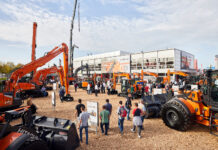In order to lift a blower weighing approximately two tonnes onto the roof of the Montparnasse Station in Paris for its customer Axima, crane service provider Ponticelli Frères had to face a whole series of challenges: Little space, the need to navigate a tricky traffic situation in the metropolis, and an incredibly small window of time to complete the lift.
Even before the lift, the company had to overcome a whole series of bureaucratic obstacles. “We had lots of discussions with SNCF, Paris public transportation operator RATP, the responsible department of motor vehicles, and the city council in order to agree on the best way to get the crane to the work site and operate it there,” explains Louis-Arthur de Quatrebarbes, Ponticelli Project Manager for the “Assembly and Lifts” Unit. Not surprising, as the undertaking was enormously complex. For example, bus lanes and pedestrian walkways around the work site had to be rerouted temporarily. In addition, the tight space conditions at the site made it necessary to precisely organize everything down to the very last detail and prepare an elaborate site map for all components and loads.

Double strategy: Crane setup with two teams
Just getting the crane to the work site at the back of the Montparnasse Station took meticulous planning as well: “We drove the AC 500-2 from our branch office in Vitry-sur-Seine, south of Paris, to the Montparnasse site within an hour on Sunday night. To save time, we used two teams with seven assembly technicians in order to set up the crane. A total of 12 trucks were required in order to transport all attachments and crane accessories, as well as the required 180-tonne counterweight,” Louis-Arthur de Quatrebarbes reports.
In line with the conditions at the site, the AC 500-2 had to be configured to lift loads of up to five tonnes at a radius of 96 meters to a maximum height of 85 meters. “To achieve this, we set it up with a WIHI-SSL configuration with a luffing fly jib and with the full counterweight,” explains crane operator Jeoffray Lefort, who specializes on “large crane heavy-load lifts” with the AC 500 and AC 700 cranes at Ponticelli.
Working at the limits
In order to get the crane ready for the lift, the two assembly teams required the help of a 100-tonne assist crane and two days, including a night shift. The fact that the AC 500-2 was set up so quickly had plenty to do with its ease of assembly, but also with the proven expertise of the Ponticelli team. For the actual lifts, the team was beefed up to have a total of twelve employees. For the constrained space conditions, Ponticelli wanted to use a 500-tonne crane. In order to use the maximum crane capacity, the smallest hook block possible was chosen.
Not three. Two.
Accordingly, the Ponticelli team made sure to check with Terex Cranes whether it would be technically possible to forego the use of the standard hook with three-part reeving for the lift and instead use a smaller hook with two-part reeving. “Once we got the green light from Terex Cranes, there was nothing in the way of using the AC 500-2, and we were able to forego using a bigger crane,” reports Louis-Arthur de Quatrebarbes. This made it possible to successfully complete the job as scheduled, and after a mere week, this extraordinary project in Paris was completed.



![[Video] New Generation DAF Trucks in ‘Construction Simulator’ Game](https://www.heavyquipmag.com/wp-content/uploads/2024/12/DAF-trucks-218x150.jpg)
![[Job Story] New Develon DD130 Dozer at Work in Portugal](https://www.heavyquipmag.com/wp-content/uploads/2025/01/Joel-Pereira-Administracion-CS-Retail-Construcoes_red-218x150.jpg)




![[Job Story] Epiroc at Work on a Demolition Site in Eisenberg](https://www.heavyquipmag.com/wp-content/uploads/2024/12/Epiroc-218x150.jpg)

 Copyright 2017-2025 All rights reserved.
Copyright 2017-2025 All rights reserved.